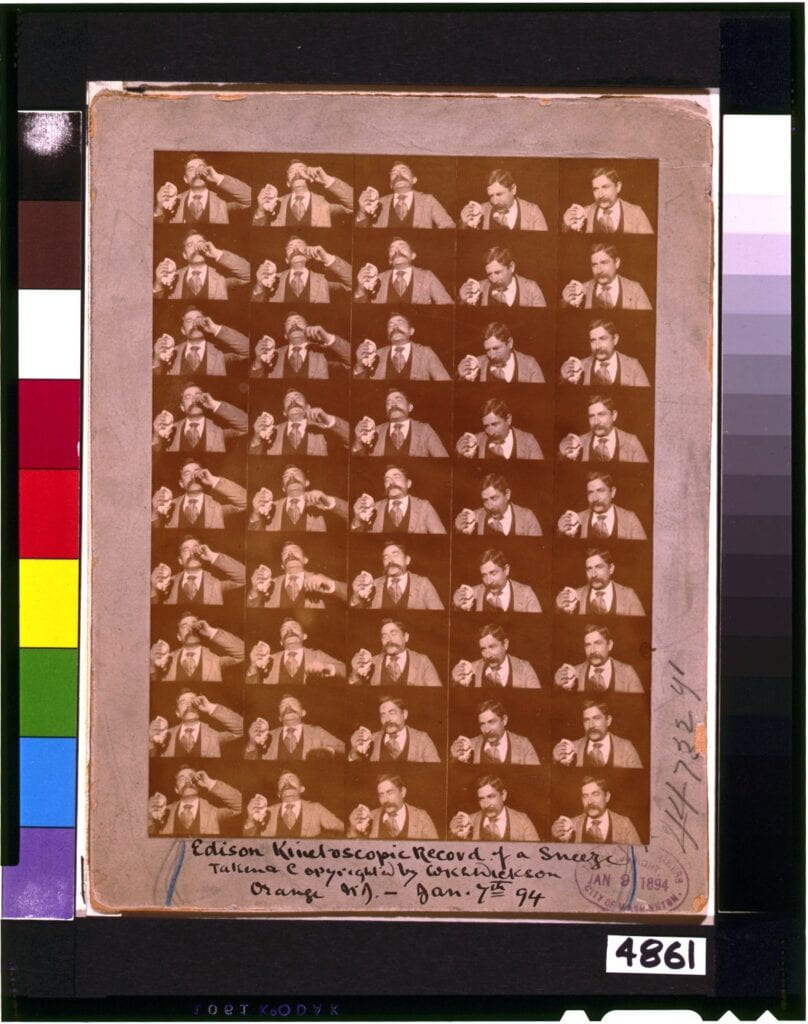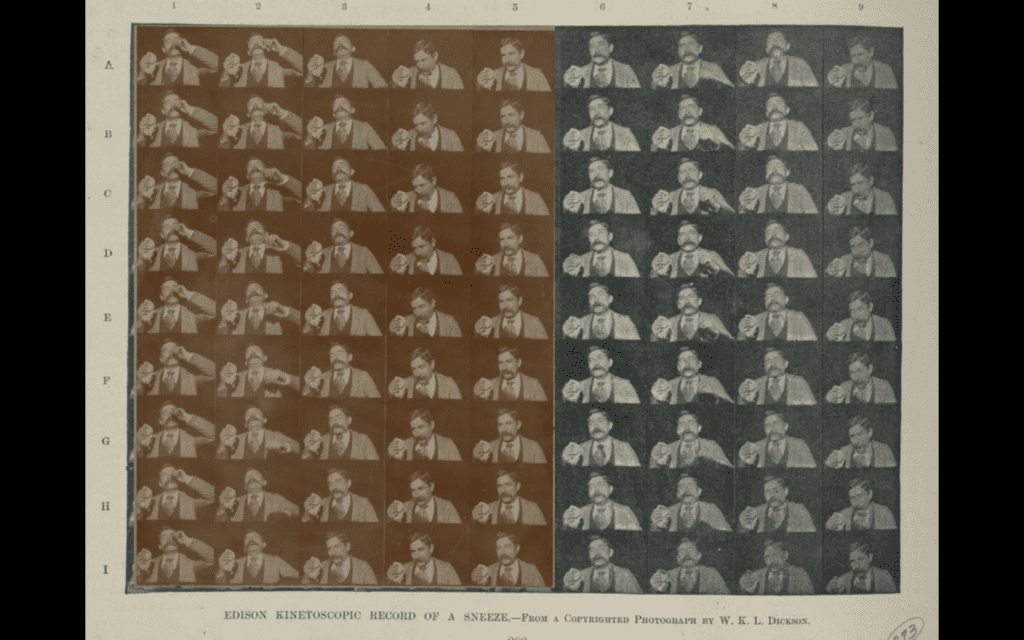Happy January 7th! Two thousand twenty-three begins with a film premiere of sorts for Edison Kinetoscopic Record of a Sneeze, January 7th, 1894.
The day is an anniversary for the milestone of cinema commonly known as Fred Ott’s Sneeze. In 1894, Thomas Edison instructed W. K. L. Dickson to make a demonstration recording of their new Kinetoscope and to send a photographic illustration to Harper’s Weekly, which had requested a sneeze.
This marks the web debut of the Library of Congress restoration, which begins with the familiar footage (first reanimated in 1953) and ends with the additional frames published in Harper’s, March 24, 1894. It’s one continuous take — in which Fred Ott sneezes twice!
The image quality between that taken from the 45 frames in the copyright photograph and the additional 36 frames in Harper’s half-tone print is of course striking.
Here’s the same, repeated ten times, as seen in LOC’s 35mm film print, created in 2013.
Or watch it here: vimeo.com/787228842
For the completists and projectionists, here’s same with 40 seconds of roll-in, countdown leader, animated LOC Packard Campus logo, and head title card before the original footage begins.
Below is an earlier post documenting the media archaeology of The Sneeze and its varying appearances, culminating in 2013-14.
As part of this website’s annotated filmography of all works shown at the 2014 Orphan Film Symposium, the descriptions below are for items shown as part of this presentation:
Dan Streible, “A New Look at an Old Sneeze: Edison Kinetoscopic Record of a Sneeze,” 9th Orphan Film Symposium, Obsolescence, Eye Filmmuseum, Amsterdam, Mar. 31, 2014. Includes live accompaniment by Stephen Horne. 27 min. Audio here.
Recorded in January 1894, Fred Ott’s Sneeze (as it came to be known) was not seen as a moving image until reanimated from still photographs to 16mm film in 1953. The many film histories written before and after that year mistakenly refer to The Sneeze as a motion picture that circulated publicly, first on Edison kinetoscope viewers. All instances of The Sneeze on film, video, DVD, television, or the internet are derived from this 16mm copy, itself made from only one of two composite photographs on deposit at the Library of Congress (via. the U.S. Copyright Office) since January 9, 1894. Kemp R. Niver and his small company in Los Angeles did the preservation work for the LOC Paper Print Film Collection, in partnership with the Academy of Motion Pictures Arts and Sciences. The copyrighted work from W. K. L. Dickson showed 45 frames on paper, printed from the original 35mm Edison film.
When I read the March 24, 1894 publication of Edison Kinetoscopic Record of a Sneeze in Harper’s magazine, I saw it consisted of 81 frames (a 9 x 9 grid). After research documented that no reanimated copies used all of the available frames, I asked the Library of Congress (National Audio-Visual Conservation Center) about this in 2013. Straight away, the Moving Image Section team had the Harper’s piece (81 frames on 1894 paper) and the copyright deposit card (45 frames) sent to the lab in Culpeper, Virginia. By September, LOC produced a bright, sharp new 35mm print that married the two sources into a longer version of Fred Ott’s Sneeze. A version never before seen as a moving image.
For the premiere screening of this 35mm restoration, Mike Mashon of the Library of Congress and I presented it at the Indiana University Cinema for the film symposium entitled Orphans Midwest: Materiality and the Moving Image, September 27, 2013. [Audio here: Dan Streible, “Versions of ‘Films’: Kinetoscopic and Digital.” 14 min.]
Next, Eye Netherlands Filmmuseum projected Fred’s re-premiere on 35mm for my presentation “A New Look at an Old Sneeze: Edison Kinetoscopic Record of a Sneeze,” March 31, 2014. (The title itself alludes to a 1961 essay by historian Gordon Hendricks, “A New Look at an ‘Old Sneeze,’” Film Culture 22/23.) Worth noting for this study of how iterations and editions of works get reproduced in multiple forms: LOC’s 35mm print of the full-length Sneeze that debuted at Indiana University in 2013 was not locatable when Eye requested shipment to Amsterdam for Orphans 9. Therefore the print projected at Eye was the Library’s second new 35mm print struck from the 2013 preservation negative.
(1) Edison Kinetoscopic Record of a Sneeze, Jan. 7, 1894 (W. K. L. Dickson, US, 1894) 13 sec. .MOV file, sound, b&w.
Source: Library of Congress YouTube channel, Mar. 26, 2009. The added sound is the voice-over identification at the before and after the original film.
Video also here: www.loc.gov/item/00694192/.
(2) Edison Kinetoscopic Record of a Sneeze, January 7, 1894 (W. K. L. Dickson, US, 1894) 5 sec. Alternate titles: Fred Ott’s Sneeze; Ott’s Sneeze; The Sneeze, short version (ca. 1955): derived from 45 still images from one of the two copyright deposit cards. 35mm print, silent, b&w, 4 ft. (transfer speed at 16fps). Camera: William Heise. Performer: Fred Ott.
Source: Library of Congress, FEC 8091 (AFI/Gordon Hendricks Collection), 1994.

3) Edison Kinetoscopic Record of a Sneeze, January 7, 1894 (W. K. L. Dickson, US, 1894) 3 min. longer version (2013); 35mm print created using 81 still images (45 from the copyright deposit card and 36 additional half-tone images published in Harper’s Weekly, March 24, 1894). This version shows Fred Ott sneezing twice, in one continuous take. This double-sneeze take is printed ten times on the 2013 film print. 35mm, silent, b&w. If run at 24 frame per second, the duration of each take is little more than 5 seconds. The 2013 digital intermediate, made before output to 35mm motion-picture film negative and positive print, retained the amber color of the original copyright deposit cards. But the LOC preservation lab only processes black-and-white film.
Source: Library of Congress.

(4) excerpt from Reclaiming American History from Paper Rolls by the Renovare Process (Primrose Productions, US, 1953). Produced and narrated by Kemp Niver. 2 of 18 min. MOV, sound, color. Demonstrating how paper prints were converted to 16mm motion-picture film; a compilation is introduced with narrator saying the film is The Sneeze — deposited for copyright in 1891 [sic] rather than 1894. Many published sources provide incorrect dating on the film, anywhere between 1888 and 1900, despite its full title containing the correct year. Watch at www.loc.gov/item/mbrs00144505.
Source: Library of Congress
(5) Thomas Alva Edison — outtakes (US, Mar. 15, 1930) 88 seconds. Fox Movietone News story 5-537. MOV, sound, b&w. Camera: William Storz; sound: Jim Duffy. Thomas Edison walks and talks with Fred Ott in Fort Meyers, Florida. As the film runs out Edison looks at someone off camera and gestures toward Ott saying “Reminds you of that motion-picture actor.”
Source: University of South Carolina Moving Image Research Collections Fox Movietone News Collection. Watch online: digital.tcl.sc.edu/digital/collection/MVTN/id/2409/rec/1.
(6) excerpt (2 min.) from 30th Academy Award Show (NBC, US, 1958); segment “50th Anniversary of the American Motion Picture,” begins with footage (2 seconds) from Fred Ott’s Sneeze; MOV file, sound, b&w. Performers: David Niven; Donald Duck (voiced by Paul Frees), with nephews Huey, Dewey, and Louie; Fred Ott.
Source: Academy Film Archive, ©A.M.P.A.S.
Not the first television broadcast of the film but its first big audience. In late 1953 LOC and AMPAS announced some paper-to-film restorations — including The Sneeze — were available as 16mm prints, some local television programs aired samples soon thereafter. Newspaper items described that Sneeze was the most difficult to copy, because its frames existed only on a single piece of 8×10″ paper. In June 1954, the ABC-TV national network program You Asked for It featured the Primrose Productions compilation, mentioning The Sneeze in promotions. (Los Angeles Times, June 24, 1954.)
(7) Edison Kinetoscopic Record of a Sneeze, January 7, 1894 / Thomas A. Edison, Inc. (anon. [David Shepard], 1971) 2 min. Alternate title: The Films of Thomas A Edison presented by Raymond Rohauer [sic]. 35mm, silent, b&w, 169 ft.
Source: Library of Congress, FEB 9185 (E. Fulton Brylawski Collection, received 1989), FEB 9186 (AFI/Shepard (David) Collection, received 1977).
Notes from the LOC catalog record: “New edition, with editing and additional matter / directed, produced and written by David Shepard.” Also: “This film is a spoof on the copyrighting of re-edited silent films. It consists of a comic written introduction tacked onto a very brief original film.” And “Copyright notice on film: Raymond Rohauer; 1971 (notice is bogus per AFI/Shepard (David) file). Alternate title, The sneeze, from leader.”
But did Rohauer literally try to register this film for his own copyright? Shepard told me (in 2013 emails) he gifted 16mm prints of his playful parody to numerous fellow film collectors as Christmas presents. Rohauer himself received a copy and reportedly appreciated the tease about his (sometimes dubious) copyright practices. Shepard surmised that an additional print of his film is catalogued as from the Brylawski Collection because Brylawsi was Rohauer’s attorney — and that Rohauer might have attempted to copyright the Shepard parody.
And did later filmmakers use Shepard’s 1971 spoof as footage representing the 1894 Sneeze? An award-winning University of South Carolina student film, Fred Ott’s Sneeze Through the Ages (Gary M. Atkins, 1975) uses (knowingly or not) the Shepard footage, which interjects two intertitles — “Ahhh—” and “—Chooo!!!” (See #9 below.)
Bonus note (not from the catalog): George Willeman put a jaunty organ soundtrack to the silent film: “Jolly Coppersmith” and “Butcher Boy,” from the LP recording Al Melgard at the Chicago Stadium Organ: World’s Largest Theatre Pipe Organ (Audio-Fidelity, US, 1958?). Hence, a new edition on his personal YouTube channel (@nitratefury):
(8) Raymond Rohauer presents “The Sneeze” (Geo. Willeman, Aug. 10, 2011).
Here Mr. Ott holds his handkerchief in his left hand. In the original and its other descendants it’s in his right. Was Shepard having fun with this “error”? Not unlikely.
(9) Fred Ott’s Sneeze through the Ages (Gary M. Atkins, 1975) alternate title (2016): Variations on a Theme: “Fred Ott’s Sneeze” through the Ages. 18 min. Super 8mm, synch-sound. Produced at the University of South Carolina. Festival awards: Ann Arbor Super 8; Atlanta Independent; Greenville Arts. Parodies Méliès, Griffith, Flaherty, Murnau, Eisenstein, Kuleshov-Pudovkin, Vitaphone, Technicolor, French cinema verité, Peckinpaugh, Bergman, and PBS. Also: “A parody of the ‘Film as an Art Form’ educational film we saw too many of in college film classes.”
David Shepard watched this shortly after it appeared on YouTube and emailed to say that he found it “brilliant.” “I laughed and laughed.” (Feb. 1, 2014).
____________
Thanks of course to Library of Congress informants who made all of this possible: Paul Spehr (retired acting Chief of the Motion Picture and Recorded Sound Division), Pat Sheehan (emeritus), Mike Mashon (Head, Moving Image Section), Ken Weissman (Supervisor, Film Preservation Laboratory), George Willeman (Nitrate Vault Manager), cataloger Andrea Leigh (Head, Moving Image Processing Unit), paper print specialist Alexis Ainsworth (Processing Technician), and reference librarian Zoran Sinobad (Moving Image Research Center). And Charles Musser for his multiple invaluable publications and consultations about the Edison films.
Update:
After the Orphans Midwest (2013) and Orphans 9 (March 2014) screenings, I also presented the films at these events:
• “A New Look at an Old Sneeze,” Amazing Tales from the Archives, San Francisco Silent Film Festival, May 30, 2014, with live musical accompaniment by Stephen Horne;
• “Kinetoscopic Records and Digital Objects: Another New Look at an Old Sneeze,” Domitor Conference, The Image in Early Cinema: Form and Material, University of Chicago, June 22, 2014.
• “‘A New Look at an Old Sneeze,’ Kinetoscopic Records as Paper, Digital, and Film,” The Reel Thing XXXIV Technical Symposium, Lucas Theater, Savannah, GA, Oct. 9, 2014.
